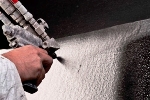
Technology
A Ceramic Coating without VOCs
The secret is in the manufacturing and application processes, not the chemical makeup.
- By Del Williams
- Jan 10, 2011
EonCoat LLC, a Wilson, N.C., company, has used ceramic coating technology developed by Argonne National Laboratory (ANL) to reinvent the way paint and coatings are made and used to get rid of hazardous volatile organic compounds (VOCs) and odor.
ANL originally created Ceramicrete for the Department of Energy to shield radioactive waste. EonCoat took that technology and, after additional research and development, discovered a method of manufacture and application that eliminates VOCs. EonCoat consists of two, non-hazardous ingredients that do not interact until applied by a plural component spray gun like those commonly used to apply polyurethane foam or polyurea coatings. Because the components are not mixed and do not meet prior to application, VOC-generating ingredients can be eliminated.

EonCoat is made up of two non-hazardous ingredients that do not interact until applied by a plural component spray gun.
The material is a true ceramic — not a polymer with ceramic beads — and it delivers a corrosion-resistant coating suitable for use in the industrial and commercial sectors. Applications can range from painting a steam line for corrosion under insulation (CUI) protection at temperatures over 1250 °F to painting hotel and restaurant walls for a beautiful, tough, fireproof barrier. In third party testing, the coating has proven up to 10 times more abrasion resistant than most paints and epoxies. A chemical-resistant barrier for cement, steel, and wood substrates, it’s chemically stable and nearly insoluble, so it’s waterproof and even most acid spills can be cleaned up without damaging the coating.
In contrast to paint polymer coatings that sit on top of the substrate, EonCoat bonds through a chemical reaction with the substrate, and slight surface oxidation actually improves the reaction. This makes it virtually impossible for corrosion promoters like oxygen and humidity to get behind the coating.
Andy Robbins, CEO of A & K Painting, a Charlotte, N.C.-based industrial and commercial paint contractor, first heard about the product at a conference about a year ago, and the concept intrigued him.
“The environmental guidelines of the last decade are rapidly becoming standards,” Robbins explained. “Since environmental codes are tightening for new builds, remodels, and existing facilities, reducing or eliminating VOCs in paint has been a growing concern for us and our customers.”
Robbins stayed in touch with the product developer; ultimately visiting the plant, participating in testing, and providing R & D feedback.
“For industrial and commercial customers looking to limit VOCs and HAPs to meet stricter regulation, EonCoat is a proactive way to do so,” he said. “There are no fumes. Contractors could literally spray within 10 feet of someone working in an occupied space with no concern for odor or getting residue on carpet, computers, or office furniture.”
A true ceramic shell covers the corrosion barrier, protecting against high-pressure power washing and steam cleaning. Food facility managers, for example, could convert interior spaces into sanitize-ready, wash-down areas because the coating can withstand water pressure of 4,500 psi/310 bar and steam at over 380 °F/193 °C.
Beyond environment and health regulations, the coating can help facility managers better protect their assets. The ceramic coating has a flame spread rating of zero, which means that a coated surface will not catch fire unless enough heat is generated to make the substrate behind the coating self-ignite.
“The anti-fire, anti-water, anti-abrasion, and anti-corrosion benefits of the new protective ceramic coating make it a promising product to use for a host of applications from extending the service life of tanks, machinery, steam pipes, and cement floors to serving as a slimmer, less costly alternative to existing, bulky firewalls,” Robbins said.
According to the company, the one-coat application and minimal prep can save facility managers about half the cost of other coatings through reduced labor, reduced downtime and reduced maintenance. The coating typically costs less per gallon than the high-temperature paints or specialized epoxies it replaces. Substrate bonding and quick drying allow high build coatings in one coat, at temperatures from 35 ºF to 200 ºF, which makes it suitable for all-weather indoor and outdoor application. These product features will help cut contract labor costs.
“The protective ceramic coating is dry to the touch in seconds so there’s no wait to recoat,” said Robbins. “Contractors can high build exterior on interior surfaces immediately — even pipes, substrates, or machinery at near-freezing to near-boiling temperatures — which can expedite tight customer schedules. That means many coating jobs in occupied areas could get done in a single day or weekend, instead of taking several weekends waiting for multiple coats of primer or paint to dry,” he added.
For more information, visit the company's website page on the coating's benefits.
About the Author
Del Williams is a technical writer based in Torrance, Calif.